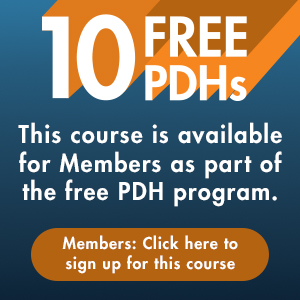

This product is available for group registration. Learn More
View Important Policies and System Requirements for this course.
This webinar was co-sponsored by ASCE's Geo-Institute (G-I) and ASCE Continuing Education
Instructor: Robert M. Koerner, Ph.D., P.E., BC.GE, Dist. M.ASCE
Course Length: 1.5 Hours
Purpose and Background
The most frequently asked question in geosynthetics is "how long will they last?" This webinar numerically quantifies this question regarding buried HDPE geo-membranes. It also discusses 19 different geosynthetics in exposed conditions: seven geo-textiles, six geo-membranes, four erosion control materials, and two geo-grids. This webinar also presents both laboratory and field half-life estimates for each of the geo-synthetics discussed and the importance of those estimates.
Primary Discussion Topics
- Importance of geosynthetic lifetime estimates
- Prediction method of elevated temperatures followed by Arrhenius modeling
- Half-life values for covered HDPE geomembranes
- Use of different laboratory weathering devices
- Results for 19 different exposed geosynthetics
- Use of radiation values to convert from laboratory to field exposures with examples given for Phoenix, Arizona
Learning Outcomes
Upon completion of this course, you will be able to:
- Determine the importance of geosynthetic durability
- Describe the laboratory procedure simulations with respect to predicting in-situ conditions
- Give covered lifetime results for the most commercially used geomembrane (HDPE) in waste containment applications
- Recognize differences of, and limitations within, laboratory weathering devices
- Give lifetime results for 19 different exposed geosynthetics
- Describe how laboratory results can be transitioned into site specific results
- Identify how all types of geosynthetics can be evaluated accordingly
Webinar Benefits
- Discuss methodology of predicting lifetime estimates from natural causes (oxygen, hydraulics, temperature, etc.) using laboratory incubation
- Learn how to use Arrhenius modeling
- Discuss how using radiation differences between the laboratory devices and any field site and field estimated lifetimes can be obtained
Assessment of Learning Outcomes
Students' achievement of the learning outcomes will be assessed via a short post-assessment (true-false, multiple choice and fill in the blank questions).
Intended Audience
- Geotechnical, transportation, geo-environmental and geosynthetic engineers
- Federal, state and regional environmental engineers
- Private and municipal land developers, architectural and landscape designers
- General and specialized civil consulting engineer
- Testing laboratories servicing these organizations
- Manufacturers and representatives of geosynthetic materials
- Contractors and installers of geosynthetics
- Academic and research groups
- Others desiring technically related information on this important aspect of geosynthetic engineering
Webinar Outline
- Background and methodology
- Covered lifetime using lab simulation
- Results for covered HDPE geo-membranes
- Exposed lifetimes using weathering devices
- Results for 19 different exposed geo-synthetics
- Summary-to-date (work is ongoing for other situations)
How to Earn your CEUs/PDHs and Receive Your Certificate of Completion
To receive your certificate of completion, you will need to complete a short on-line post-test and receive a passing score of 70% or higher within 1 year of purchasing the course.
How do I convert CEUs to PDHs?
1.0 CEU = 10 PDHs [Example: 0.1 CEU = 1 PDH]
